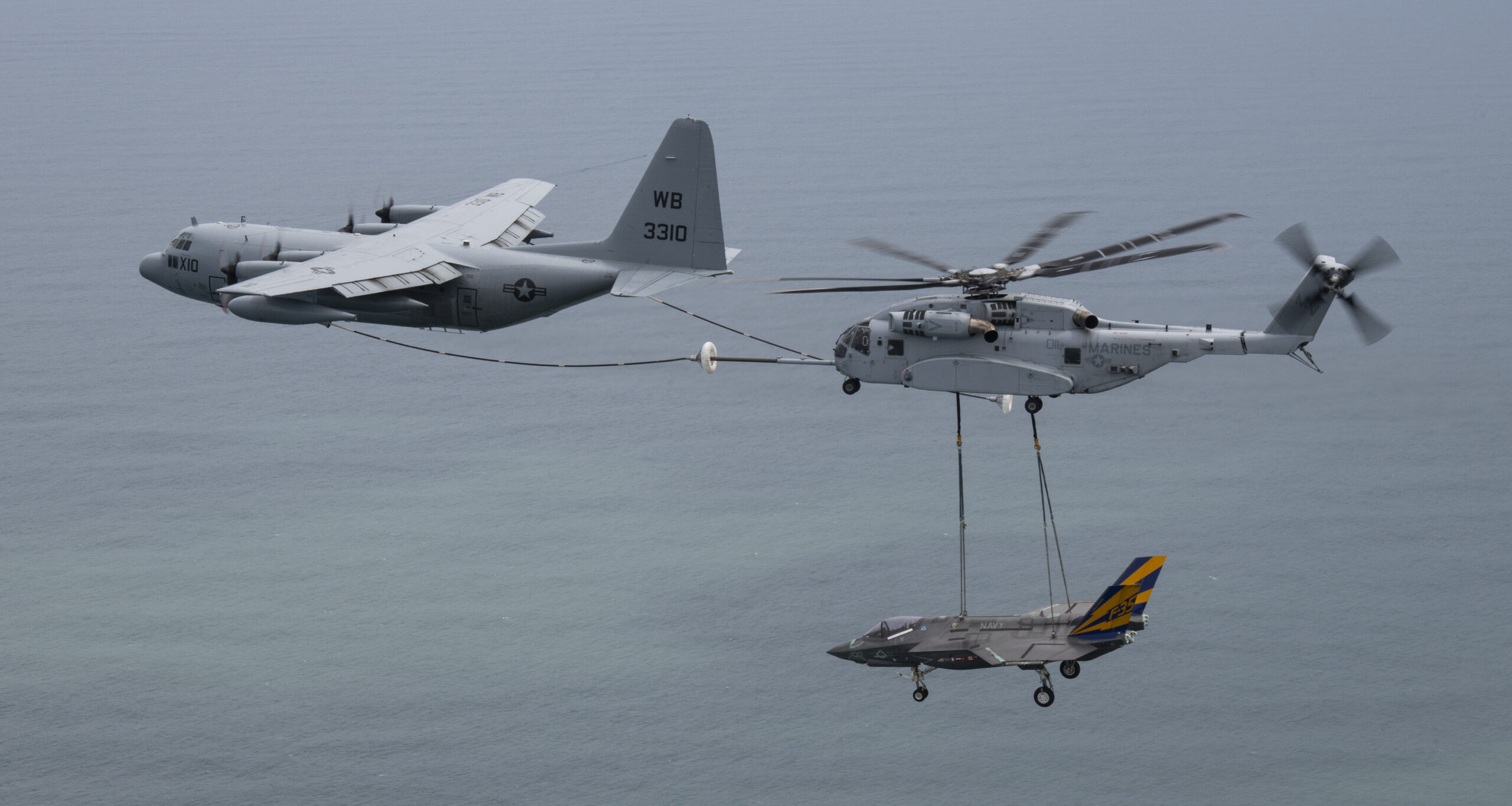

A remarkable photo released by the Navy last week captures some stunning flying by a Marine Corps test pilot and aircrew, coaxing their CH-53K King Stallion through two of the most difficult helicopter flying skills at the same time.
The photo, snapped by photographer Kyra Helwick, captures the moment a a CH-53K — the latest, most powerful version of the Marine Corps’ workhorse cargo mover — hooks up for air-to-air refueling with the extended hose of a Navy KC-130T tanker aircraft, as it flies with the airframe of a Navy F-35 fighter slung beneath it.
Both of the flying skills on display — air-to-air refueling and carrying a slingload — demand uniquely tricky flying skills.
The maximum speed most helicopters can fly with a sling load is just over 100 mph (the top speed for the CH-53k is 200 mph even without a fighter jet dangling beneath it). But a hulking, fixed-wing C-130 cannot stay in the sky if it flies slower than, well, just over 100 mph.
In other words, the crews of both aircraft are pushing their airplanes to the edge of the flying envelopes to make this picture work.
The flight was from Naval Air Station Patuxent River to an airfield in New Jersey. Nearly every part of the remarkable picture tells a tale.
Three Unique Airplanes
The CH-53k is the latest, largest and most powerful version of the CH-53, which was the Marine’ Corps’ primary airlift platform for more than half a century. Marines flew on CH-53s in Vietnam, Desert Storm and throughout the wars in Afghanistan and Iraq. However, the helicopter from those eras are retired or nearing retirement, and the remaining ones have been pushed harder than ever in recent months during the grounding of the MV-22 Osprey fleet.. A CH-53E crashed and killed 5 Marines in February.
The first K-models were delivered in 2022, with modern avionics and larger engines that the Navy says allows the helicopter to lift up to 36,000 in payload — enough to carry two upper-armor Humvees or a Light Armored Vehicle.
The King in the picture is assigned to Marine Test and Evaluation Squadron 1, which is based at Marine Corps Air Station Yuma, The unit tests and evaluates helicopters and other flying equipment for use in the fleet.
The KC-130T belongs to Air Test and Evaluation Squadron Two Zero, or V-20, a flight test squadron at Patuxent River, the Navy’s hub for flight testing of new, unique and experimental aircraft.
What makes the tanker in the picture relatively unique is that the Navy flies very few C-130s in its active fleet, and none as tankers. Helicopter-refueling tankers are generally the domain of the Air Force special ops and search and rescue forces or the Marines.
In fact, the plane in the picture — serial number 163310 — spent most of it’s flying life in those services. It was originally purchased by the Air Force as a tanker in 1986, according to databases maintained online by aviation enthusiasts. But the plane spent most of its active duty life in the Marines before ending up with the Navy in 2016.
The F-35 has is its own story. The yellow and blue lightning flashes on the tails identify it as CF-01, the first F-35 delivered to the Navy in 2010. The plane spent its entire flying career at Patuxent River. However, its been retired to be a non-flying test model, missing its engine and parts of wings, and belongs to the Prototype, Manufacturing and Test (PMT) Department of the Naval Air Warfare Center Aircraft Division Lakehurst. In fact, the photo taken last week isn’t even the first time that CF-01 has hitched a ride beneath a CH-53K.
The latest on Task & Purpose
- 75th Ranger Regiment sweeps Best Ranger, Best Mortar, and International Sniper competitions
- Married Army couple win back-to-back Sapper school awards
- Special Forces engineers are training to dig ditches and destroy tanks
- This is why Marines were at Mar-a-Lago
- Supreme Court sides with Army veteran in overlapping GI Bill benefits case